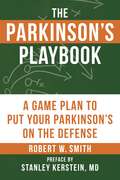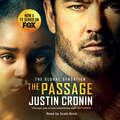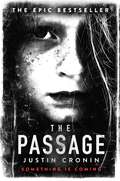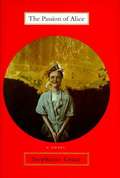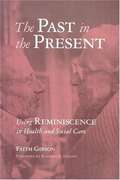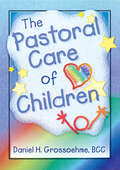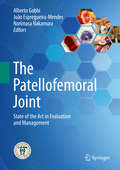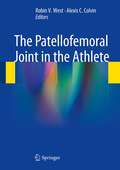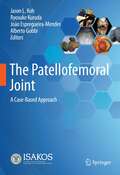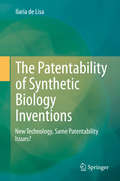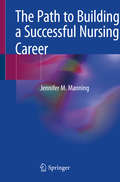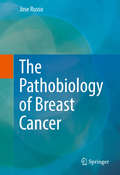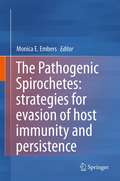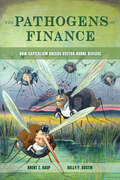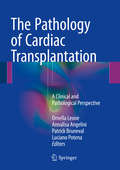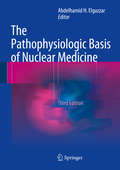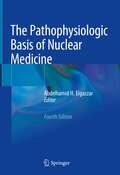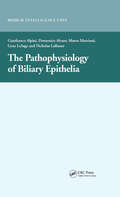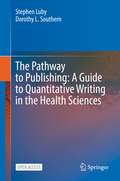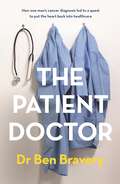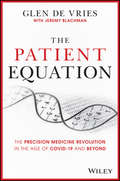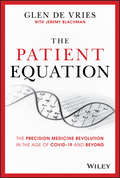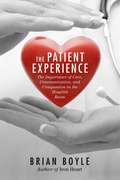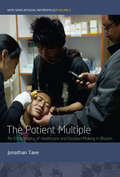- Table View
- List View
The Parkinson's Playbook: A Game Plan to Put Your Parkinson's On the Defense
by Robert Smith Stanley KersteinThe Parkinson’s Playbook puts the power in your hands, giving you the knowledge you need to proactively defend yourself against the progression of Parkinson’s disease with energy, vitality, and confidence.The diagnosis of Parkinson’s disease is not an easy one. In The Parkinson’s Playbook, author Robert Smith has prepared an enlightening and engaging “playbook” to help you tackle Parkinson’s head on, including a pro-active offense of lifestyle improvements and defensive measures including cutting-edge medications and natural healing techniques.The Parkinson’s Playbook makes you the MVP of your life—so get out there and win!Also featured in The Parkinson’s Playbook:• How to assemble a line-up of medical and emotional support systems• Learn the importance of exercise to boost strength and relieve stress• Effective, easy-to-implement diet changes for well-being...and so much more, all with the unique patient’s perspective of the author’s personal experiences fighting—and winning—against his disease.
The Paroxysmal Disorders
by Bettina Schmitz Barbara Tettenborn Donald L. SchomerThe paroxysmal disorders present neurologists and other medical professionals with diagnostic problems across a range of disorders, including multiple sclerosis, migraine and epilepsy. This new English language edition of a compendium of the paroxysmal disorders, originally published in German as Paroxysmale Störugen in der Neurologie, is an informative and practical resource for clinicians, which provides invaluable help with differential diagnosis and management. Fully updated throughout, this new edition comprehensively covers the entire spectrum of the paroxysmal disorders, including sudden falls, headache, vertigo attacks, memory loss, visual disturbances, seizures and anxiety. Each chapter is practice oriented, covering definitions, etiology, epidemiology, diagnosis, examination techniques and therapy. Detailed guidelines for gathering case-histories, essential for accurate diagnosis, are also provided. Important reading for clinicians, professionals and academic researchers working in neurology, psychiatry, epilepsy, internal medicine and ENT.
The Passage: The original post-apocalyptic virus thriller: chosen as Time Magazine's one of the best books to read during self-isolation in the Coronavirus outbreak (The Passage Trilogy #1)
by Justin CroninAmy Harper Bellafonte is six years old and her mother thinks she's the most important person in the whole world.She is.Anthony Carter doesn't think he could ever be in a worse place than Death Row.He's wrong.FBI agent Brad Wolgast thinks something beyond imagination is coming.It is.THE PASSAGE.(p) 2010 Penguin Random House LLC
The Passage: The original post-apocalyptic virus thriller: chosen as Time Magazine’s one of the best books to read during self-isolation in the Coronavirus outbreak
by Justin CroninNOW A MAJOR TV SERIES!'THE STAND meets THE ROAD' Entertainment Weekly'Enthralling ... richly imagined. Above all, Amy is a superb creation, believably human yet beguilingly enigmatic' Sunday TimesAmy Harper Bellafonte is six years old and her mother thinks she's the most important person in the whole world.She is.Anthony Carter doesn't think he could ever be in a worse place than Death Row.He's wrong.FBI agent Brad Wolgast thinks something beyond imagination is coming.It is.'Read 15 pages, and you will find yourself captivated; read 30 and you will find yourself taken prisoner and reading late into the night. It had the vividness that only epic works of fantasy and imagination can achieve. What else can I say? This: read this book and the ordinary world disappears' Stephen King
The Passion of Alice
by Stephanie GrantIt's 1984. Alice Forrester is a twenty-five-year-old anorexic who has just experienced heart failure when she is taken to the emergency room of Seaview Hospital, renowned for its eating disorders clinic. There, family and friends in league with staff and doctors intently try to steer her toward recovery. But it's not that simple. She passes time at the clinic waiting to find out what is wrong with her. What happened. When and how the damage was done. Along the way, Alice encounters a fascinating array of oddballs and misfits - Dr. Paul, the physician who clinically evaluates and monitors this disparate group of afflicted young women; various members of the psychiatric support staff whose treatment of anorexia revolves around a chillingly familiar twelve-step program; wraithlike, flaxen-haired Gwen, whose anorexia ultimately turns into tragedy; and finally Maeve, raucous, vulgar, tender, and kind, who shakes up Alice's life and opens her eyes. Alice questions many things about herself in addition to her eating disorder including her sexuality.
The Past in the Present: Using Reminiscence in Health and Social Care
by Faith GibsonThe Past in the Present is an essential reminiscence resource for nursing staff and paraprofessionals, social workers, psychologists, occupational therapists, activity directors, recreation therapists, professionals providing training programs for volunteers and family caregivers, community groups, and school and college programs providing community service and intergenerational outreach.
The Pastoral Care of Children
by Harold KoenigExplore a new way of pastoral care that enables caregivers to develop relationships and provide meaningful pastoral care to the children and youth they encounter! The Pastoral Care of Children focuses on the need for pastoral caregivers, clergy and chaplains to develop relationships with youths and gives you suggestions to overcome the anxiety associated with caring for an acutely ill child through unique, playful, and child-centered approaches. Many pastoral caregivers have high anxiety when children are ill or hurt, are unsure how to have a substantive conversation with a nine-year old, or their fears of what could be said keep them from hearing what children have to say. The effective approaches in The Pastoral Care of Children are illustrated to assist you with serving the spiritual needs of children. You will explore actual pastoral care experiences that will help you gain confidence in handling situations such as a teenager’s desire to be baptized out of fear of death when neither he nor his parents believe in Christ. Intelligent and heartfelt, this valuable book gives you a complete theological exploration of ministering to children who may ask you “Why me?”, “Why do people have to die?” and “What happens to children if they die before they are baptized?” The Pastoral Care of Children helps you answer these questions with meaningful responses that are genuine and grounded with yourself, and reflect the parents’beliefs. Some of the help you will discover in The Pastoral Care of Children includes: understanding the similarities and differences of caring for children in comparison to adults, such as different vocabularies but similar emotions, and realizing that children are very perceptive using play as a tool, for example referring to a puppet’s experience in reference to the child to eliminate the child’s self-consciousness and help him or her open up confronting pastoral issues in acute care settings, such as fear, guilty feelings, and anger, from parents, family and the child helping children recover from mental health issues such as depression, eating disorders, and identity and self-esteem issues by using cognitive therapy conducting prayer and rituals with children such as baptism, naming ceremonies, anointings, and funerals to assist the child and family through this spiritual rite of passage Complete with child and family focused approaches for dealing with the questions surrounding death, The Pastoral Care of Children also provides you with several cited scriptures, and a list of questions you may be asked by a child who is facing death. You will learn from actual circumstances pastoral caregivers have encountered and discover how to approach topics, and answer questions on God and death. The Pastoral Care of Children, an extremely resourceful book that will assist you in overcoming anxiety and help you deliver thoughtful and uplifting pastoral care to children and youth.
The Patellofemoral Joint
by Alberto Gobbi João Espregueira-Mendes Norimasa NakamuraThis book is a comprehensive and thorough compilation of work from across the world that documents the state of the art in assessment and management of the patellofemoral joint. While a wide range of surgical techniques for different pathologies are described, attention is also devoted to conservative treatment and approaches involving mesenchymal stem cells, autologous chondrocyte implantation, platelet-rich plasma, and pulsed electromagnetic fields. Anatomy, clinical examination, and methods of evaluation are discussed, and individual chapters address important miscellaneous topics, including rehabilitation, complications of surgery, injuries in specific patient populations, and scoring systems. Though patellofemoral joint pathology is a frequent clinical problem, its management remains challenging for the orthopaedic surgeon. The editors believe that this book, published in cooperation with ISAKOS, will assist in improving understanding, diagnosis, and treatment for future patients.
The Patellofemoral Joint in the Athlete
by Alexis C. Colvin Robin V. WestPatellofemoral disorders are extremely prevalent in athletes and can lead to chronic pain, instability, weakness, and inconsistent or poor athletic performance. These disorders can be difficult to diagnose. Treatment options can vary depending upon several factors, including the sport and the time during the sports season when the symptoms occur. Treatment also varies depending on the age of the patient and their competition level. The Patellofemoral Joint in the Athlete provides an extensive review of the physical examination, radiographic evaluation, differential diagnoses, and treatment options of common patellofemoral disorders, including patellar chondrosis, pain and instability. The contributors are nationally recognized experts in the patellofemoral joint that treat athletes of all ages and abilities. Appropriate for orthopedic surgeons, sports medicine physicians, rehabilitation physicians and physical therapists, this book is a comprehensive guide to the unique and sport-specific concerns of athletes of all ages and abilities with regard to the patellofemoral joint.
The Patellofemoral Joint: A Case-Based Approach
by Alberto Gobbi João Espregueira-Mendes Ryosuke Kuroda Jason L. KohThis practical case-based book assists clinicians in the evaluation and treatment of patellofemoral patients by reviewing critical elements for assessment and presenting clinical scenarios in which different experts provide their recommendations for treatment.Subdivided in 6 parts it explores the joint’s anatomy and mechanics, as well as case-based evaluation and treatment of patellofemoral instability, arthritis and chondrosis, traumatic injuries and degenerative tendinopathies. Moreover, the closing part offers an overview of the latest advances and future developments. Written in collaboration with ISAKOS, this book offers a valuable guide for orthopedists and sports medicine treating common and complex injuries of this joint.
The Patentability of Synthetic Biology Inventions: New Technology, Same Patentability Issues?
by Ilaria de LisaThis book addresses Synthetic Biology (SynBio), a new and promising biotechnology that has attracted much interest from both a scientific and a policy perspective. Yet, questions concerning the patentability of SynBio inventions have not been examined in detail so far; as a result, it remains unclear whether these inventions are patentable on the basis of current norms and case law. The book addresses this question, focusing especially on the subject matter’s eligibility and moral criteria. It provides an overview of the legislation and decisions applicable to SynBio patents and examines this new technology in view of the ongoing debate over the patentability of biotechnologies in general. The legal analysis is complemented by the practical examination of several patent applications submitted to the European and US patent offices (EPO and USPTO), and by an assessment of the patent issues that are likely to be raised by future SynBio developments.
The Path to Building a Successful Nursing Career
by Jennifer M. ManningThis textbook provides a one-stop reference resource and guide for nurses interested in advancing their careers. It addresses self-assessment, goal setting and self-discipline, as well as academic paths and non-academic career paths, and includes two chapters on strategic path development, covering internal motivation, risk taking, work—life balance, work environment, networking, professional membership and mentorship. Lastly, the book discusses professional growth topics such as civility, burnout, professional development and “keeping informed,” and explores specific professionalism topics like professional behavior, ethics, social media and executive presence.Intended for nurses at any level, this textbook examines topics relevant to today’s nursing professionals and offers guidance on building a successful nursing career. It also helps student nurses create a path for their career and professional growth, both during their training program and beyond.
The Pathobiology of Breast Cancer
by Jose RussoThis monograph, written by well renowned breast cancer expect, Dr. Jose Russo, provides new insight on the pathobiology of breast cancer from the most current advances in the field, translational research, initiation and progression of the disease, the mechanism of invasion and metastasis and the concept of stem cells in treatment and drug resistance. The role of personalized medicine and genomic testing are also explored, which will provide a window to the future progress of cancer care.
The Pathogenic Spirochetes: strategies for evasion of host immunity and persistence
by Monica E. EmbersThis book explores the many mechanisms by which the most prevalent Spirochetal pathogens persist in a healthy immune-competent host. Among them are the direct and indirect suppression of host immune signals, phase and antigenic variation, escaping recognition by host complement proteins, and seclusion into immune privileged sites. We also explore antibiotic therapy for control of infection, a baffling topic that lends itself to exalted interpretation.
The Pathogens of Finance: How Capitalism Breeds Vector-Borne Disease (Critical Environments: Nature, Science, and Politics)
by Brent Z. Kaup Kelly F. AustinThe Pathogens of Finance is an exploration of how the rising power and profits of Wall Street underpin the contemporary increases in and inadequate responses to vector-borne disease. Over the past fifty years, insects have transmitted infectious diseases to humans with greater frequency and in more unexpected places. To examine this phenomenon, Brent Z. Kaup and Kelly F. Austin take readers to the exurban homes of northern Virginia; the burgeoning agricultural outposts of Mato Grosso, Brazil; and the smallholder coffee farms of the Bududa District of eastern Uganda. Through these case studies, the authors illuminate how the broader financialization of society is intimately intertwined with both the creation of landscapes more conducive to vector-borne disease and the failure to prevent and cure such diseases throughout the world.
The Pathology of Cardiac Transplantation
by Ornella Leone Annalisa Angelini Patrick Bruneval Luciano PotenaThis is the first book to focus entirely on the role of pathology in cardiac transplantation, linked to the clinical perspective through clinical-pathological correlation, multidisciplinary team working, and collaborative research. It provides a scientific framework with up-to-date pathological protocols and classification schemes and guides the reader through the chronological phases of the transplant process in a step-by-step approach. Topics include end-stage heart failure with pathologies encountered in the native heart, current issues surrounding donor selection, the multiple faces of rejection pathology correlated with clinical management and immunology, other post-transplant complications, details of pediatric and combined heart/other organ transplantation, and a useful practical appendix. Many high-quality images and illustrative cases are presented, along with learning points and ample references. Transplantation medicine today is continuously changing as collaborative research into novel diagnostic techniques and immunosuppressive therapies translates into improved recipient management and survival. This book is aimed at practicing transplant pathologists and specialist trainees. It will also appeal to general pathologists and to physicians and surgeons involved in cardiac transplantation who need to understand the role of pathology in the clinical management of transplant recipients.
The Pathophysiologic Basis of Nuclear Medicine
by Abdelhamid H. ElgazzarThis book, now in its third edition, aims to promote a deeper understanding of the scientific and clinical basis of nuclear medicine and the new directions in medical imaging. The new edition has been revised and updated to reflect recent changes and to ensure that the contents are in line with likely future directions. The book starts by providing essential information on general pathophysiology, cell structure and cell biology as well as the mechanisms of radiopharmaceutical localization in different tissues and cells. The clinical applications of nuclear medicine are then presented in a series of chapters that cover every major organ system and relate the basic knowledge of anatomy, physiology and pathology to the clinical utilization of various scintigraphic modalities. The therapeutic applications of nuclear medicine are discussed in a separate chapter, and the final chapter is devoted to the biologic effects of ionizing radiations, including radiation from medical procedures.
The Pathophysiologic Basis of Nuclear Medicine
by Abdelhamid H. ElgazzarThis book, now in its fourth edition, aims to promote a deeper understanding of the scientific and clinical basis of nuclear medicine and the new directions in medical imaging. The new edition has been revised and updated significantly to reflect recent changes and to ensure that the contents are in line with likely future directions. In addition to that, chapters have been reorganized in order to simplify the contents and to increase the readability. The book starts by providing essential information on general pathophysiology, cell biology and biologic effects of ionizing radiation followed by the mechanisms of radiopharmaceutical localization in different tissues and cells. This is followed by a series of chapters that covers all relevant organ systems presenting the basic knowledge of anatomy, physiology, and pathology and relating them to the clinical utilization of various scintigraphic modalities. The final chapter is devoted to the basis of therapeutic applications of nuclear medicine. The book will prove invaluable to all with an interest in the pathophysiologic basis of Nuclear Medicine, including nuclear medicine professionals, radiologists, surgeons, pediatricians and internal medicine physicians.
The Pathophysiology of Biliary Epithelia
by Gianfranco AlpiniThis book is a comprehensive review of the biliary epithelia pathophysiology. Biliary epithelial cells (also referred to as cholangiocytes) line the intra- and extrahepatic bile ducts. Cholangiocytes have immerged in the last several years as one of the more important epithelial cells in the gastrointestinal system due to their large contribution to bile formation and tendency to be involved in human diseases.The book’s 35 chapters represent a nearly complete review of the function and disease of bile ducts. The gestational development of bile ducts is shown to be a complex interaction between hepatocyte and biliary precursors. The structure of bile ducts can be defined by ultrastructural studies and by 3D reconstruction studies which show that the bile duct system resembles a tree. The array of membrane transporters and channels involved in ductal absorption and secretion of water and electrolytes is reviewed. Like other gastrointestinal epithelial cells, the physiologic responses of cholangiocytes are regulated by hormones, nerve input, cytokines, factors in bile and intracellular signals (e.g., cyclic AMP and intracellular calcium). The potential role of the cholangiocyte in production of collagen in cholestatic liver disease is discussed. A number of important models used in the study of cholangiocyte physiology and reactions to injury are reviewed. Finally the relationships between the cholangiocyte responses and human liver diseases are discussed.While many basic scientists and hepatologists who devote their careers to the study of the liver will find this book useful, the intended audience of this book is the more heterogeneous group of individuals who study clinical and/ or basic science digestive physiology and due to their interest in epithelial function will find the cutting edge information in this book both enlightening and useful to their progression of their work.
The Pathway to Publishing: A Guide to Quantitative Writing in the Health Sciences
by Stephen Luby Dorothy L. SouthernWriting manuscripts is central to the advance of scientific knowledge. For an early career aspiring scientist, writing first author manuscripts is an opportunity to develop critical skills and to credential their expertise. Writing manuscripts, however, is difficult, doubly so for scientists who use English as a second language. Many science students intentionally avoid a writing-intensive curriculum. Careful, thorough reviews of draft manuscripts are difficult to secure, and experienced scientific supervisors face more demands on their time than they have time available. Weak draft manuscripts discourage supervising scientists investing the time to coach revisions. It is easier for experienced scientists to ignore the request, or to simply rewrite the article. Early career scientists are motivated to address these barriers but specific advice is difficult to find, and much of this advice is behind a pay wall. This essential, open access text presents writing lessons organized as common errors, providing students and early-career researchers with an efficient way to learn, and mentors with a quick-reference guide to reviewing. Error descriptions include specific examples drawn from real-world experiences of other early-career writers, and suggestions for how to successfully address and avoid these in the future. Versions of this book have been used by Stanford University, UC Davis, Johns Hopkins, and numerous international institutions and organizations for over a decade.
The Patient Doctor: How one man's cancer diagnosis led to a quest to put the heart back into healthcare
by Dr Ben BraveryAt the age of twenty-eight, with his Beijing-based science communications business doing well and a new relationship blossoming, Ben Bravery woke from a colonoscopy to be told he had stage 3 colorectal cancer. As a scientist, Ben understood the seriousness of his condition. Cancer had quite literally whacked him in the guts, after all. But what he didn't expect was how being a patient, and a young one at that, would make him feel. Why hadn't he been better prepared for the embarrassment and vulnerability of lying naked on the radiation table? Why wasn't he warned about the sheer number of tubes he would discover coming out of his body after surgery? Why did it feel like an imposition to ask doctors about his pain on their ward rounds? And why did he have to repeat the same information to them over and over again? During eighteen long months of treatment, including aggressive chemotherapy, Ben felt scared, overwhelmed, sometimes invisible and often alone.As he recovered, it struck Ben that after everything he'd been through he couldn't go back to his former career. He needed a change - and he wanted to make change. He wanted to become a doctor. He passed the entrance exam and dived headfirst into the challenges of medical school - including an unrelenting timetable, terrifying ward rounds and the difficulty of maintaining compassion under pressure.Now, driven by his experience on both sides of the healthcare system, this patient-turned-doctor gives a no-holds-barred account of how he overcame the trauma of his illness to study medicine and shares what he believes student doctors, doctors, patients and their families need to do to ensure that the medical system puts the patient at the very heart of healthcare every day.Honest, powerful, eye-opening and sometimes heart-wrenchingly funny, this is an inspiring memoir that shows that no matter our situation we all need to be treated with care and compassion, right until the very end.
The Patient Equation: The Data-Driven Future of Precision Medicine and the Business of Health Care
by Glen de VriesHow the data revolution is transforming biotech and healthcare—and why you can’t afford to let it pass you by We are living through a time when the digitization of health and medicine is becoming a reality, with new abilities to improve outcomes for patients as well as the efficiency and success of the organizations that serve them. In The Patient Equation, Glen de Vries presents the history and current state of life sciences and healthcare as well as crucial insights and strategies to help scientists, physicians, executives, and patients survive and thrive in the current disruptive, tech-driven landscape. The biggest challenge facing biotech, pharma, and medical device companies today is how to integrate new knowledge, new data, and new technologies to get the right treatments to the right patients at precisely the right times. This book shows you how to meet that challenge and embrace the data revolution. Drawing on the fascinating stories of businesses and individuals that are already making inroads—from a fertility-tracking bracelet changing the game for couples looking to get pregnant, to an entrepreneur reinventing the treatment of diabetes, to Medidata’s own work bringing clinical trials into the 21st century—de Vries shares the breakthroughs, approaches, and practical business techniques that allow companies to stay ahead of the curve and to deliver solutions faster, cheaper, and more successfully—while still upholding the principles of traditional therapeutic medicine. How one rare disease is leading the way for new approaches to understanding precision medicine What it means to build robust, effective disease management platforms Why value-based reimbursement is changing the business of life sciences How the right alignment of incentives will improve outcomes at every stage of the patient journey Whether you’re a scientist, physician, or executive, you can’t afford to let the data revolution pass you by: understand the landscape with this must-read roadmap for success—and see how you can change the future of healthcare for the better.
The Patient Equation: The Precision Medicine Revolution in the Age of COVID-19 and Beyond
by Glen de VriesHow the data revolution is transforming biotech and health care, especially in the wake of COVID-19—and why you can’t afford to let it pass you by We are living through a time when the digitization of health and medicine is becoming a reality, with new abilities to improve outcomes for patients as well as the efficiency and success of the organizations that serve them. In The Patient Equation, Glen de Vries presents the history and current state of life sciences and health care as well as crucial insights and strategies to help scientists, physicians, executives, and patients survive and thrive, with an eye toward how COVID-19 has accelerated the need for change. One of the biggest challenges facing biotech, pharma, and medical device companies today is how to integrate new knowledge, new data, and new technologies to get the right treatments to the right patients at precisely the right times—made even more profound in the midst of a pandemic and in the years to come. Drawing on the fascinating stories of businesses and individuals that are already making inroads—from a fertility-tracking bracelet changing the game for couples looking to get pregnant, to an entrepreneur reinventing the treatment of diabetes, to Medidata's own work bringing clinical trials into the 21st century—de Vries shares the breakthroughs, approaches, and practical business techniques that will allow companies to stay ahead of the curve and deliver solutions faster, cheaper, and more successfully—while still upholding the principles of traditional therapeutic medicine and reflecting the current environment. How new approaches to cancer and rare diseases are leading the way toward precision medicine What data and digital technologies enable in the building of robust, effective disease management platforms Why value-based reimbursement is changing the business of life sciences How the right alignment of incentives will improve outcomes at every stage of the patient journey Whether you're a scientist, physician, or executive, you can't afford to let the moment pass: understand the landscape with this must-read roadmap for success—and see how you can change health care for the better.
The Patient Experience: The Importance of Care, Communication, and Compassion in the Hospital Room
by Brian BoyleBrian Boyle tells a personal story of his fight back from near death after a horrific automobile accident. He focuses on his experience as a patient who, while in a two-month long medically induced coma, was unable to move or talk to anyone around him, yet he was able to hear, see and feel pain. Brian slowly clawed his way back to the living and found the strength to live to tell his story in his acclaimed memoir, Iron Heart. Now Brian provides vital information from the patient’s perspective to help caregivers gain valuable insight that will help them understand new ways on how to provide care to both patients and their families. By completion of this book, the participant will be able to: Recognize the variety of feelings and emotions of the patient Identify simple methods and interventions to provide emotional support to relax the patient Determine the importance of particular amenities to a patient who may be unable to communicate Evaluate patient life-history to determine appropriate intervention techniques Understand the motivational role that communication has between the healthcare provider and the patient and his or her family Brian’s story about catastrophe, survival, and transcending all odds has implemented new and innovative strategies for improving patient safety and quality of care on a national level, as well as serving as a learning experience for healthcare providers of all levels and backgrounds. When it comes to the patient experience, Brian has become a mouthpiece for the voiceless.
The Patient Multiple: An Ethnography of Healthcare and Decision-Making in Bhutan
by Jonathan TaeeIn the Himalayan Kingdom of Bhutan, medical patients engage a variety of healing practices to seek cures for their ailments. Patients use the expanding biomedical network and a growing number of traditional healthcare units, while also seeking alternative practices, such as shamanism and other religious healing, or even more provocative practices. The Patient Multiple delves into this healthcare complexity in the context of patients' daily lives and decision-making processes, showing how these unique mountain cultures are finding new paths to good health among a changing and multifaceted medical topography.
